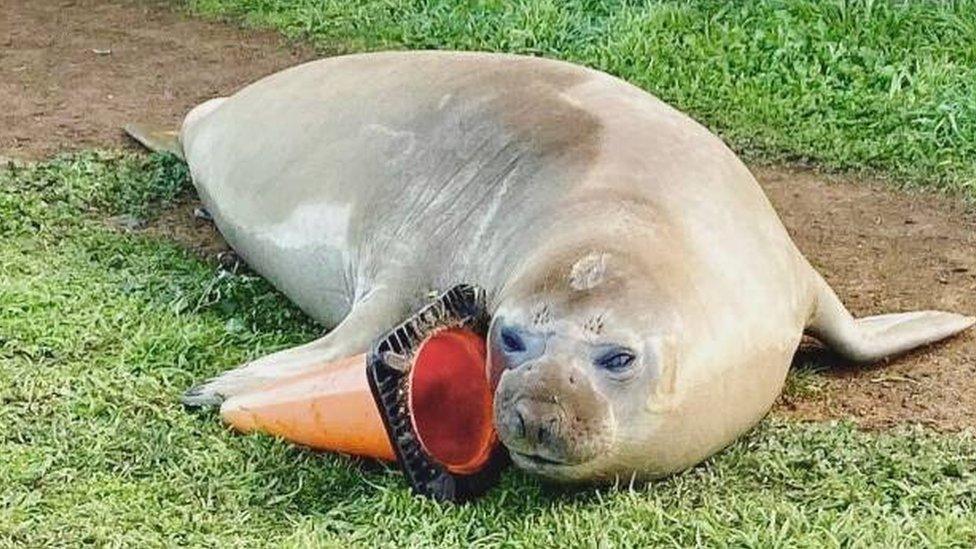Neil the seal - Tasmania's latest viral sensation and why you should stay away from him
- Published
- comments

This 600kg southern elephant seal has been causing a stir on the Australian island of Tasmania, appearing in the streets rather than his usual home by the sea.
He's been nicknamed Neil the Seal and has gathered a large social media following after some of his unusual antics were captured on video.
The seal has been seen lying in front of a local estate agents' office, causing a commotion outside a fish and chip shop, and even blocking a woman from getting into her car.
Of course there's now an Instagram account named after him with more than 63,000 followers, plus TikTok posts and YouTube videos showcasing his adventures, all of which have been getting millions of views.
Photos and videos of Neil chomping on traffic cones, disfiguring road marker posts, or inconveniencing traffic, have led to the seal attracting crowds, many wanting to film his funny behaviour for themselves.
Items like T-shirts and soft toys are also being sold in his name, and there's even been a song written about him.
But his rising fame has begun to make marine experts uneasy about his welfare.
Sign telling people to keep away from Neil have been put up in the areas where he has been spotted
We need to remember these are wild animals.
Why do experts want people to stay away from Neil?
According to the Department of Natural Resources and Environment Tasmania, southern seal elephants will move their bulk with speed if harassed, which can also be dangerous for humans.
Southern elephant seals are the largest of all seal species. Males can reach up to 4-5 metres in length and weigh up to 3,500kg - roughly the same as a van. Females are usually a bit smaller - usually less than 3m long and weighing about 500 kg or the same as a grand piano.
Mary-Anne Lea, professor from the Institute for Marine and Antarctic Studies at the University of Tasmania, said: "It's OK when animals are cute and interacting in generally safe ways, but then they become bigger and other natural behaviours kick in - along with their hormones - and you can start to have interactions that you are less fond of."
What has been done to try and protect Neil?
As Neil's popularity has grown grew, authorities said they have had to repeatedly urge people to "keep their distance, keep dogs on a lead and away from the seal".
In April, Neil was "relocated" from a popular Tasmanian beach near Hobart because his presence was attracting too many onlookers.
To help keep track of his whereabouts, wildlife rangers fitted Neil with a tracking device, to "help quickly identify if he turns up in another challenging location and to learn more about his behaviour".
The Tasmanian resident who set up the Instagram page for "Tassie locals" and their children to learn about Neil's behaviour, said they no longer posted his up-to-date location to ensure his safety.
The decision was made after taking advice from marine biologists.
A post on the Instagram account said: "I would ask everyone that engages with Neil to please remember that he is not there for our financial gain, he is a wild creature with his own unique personality and deserves the respect of all people."
Neil has often been seen lying in the road with traffic cones
It's thought Neil came on a "haul out", a period in which seals come to land to rest, in July 2022.
During this time the animals take time to recuperate and if they are female can even give birth.
This is also when they would go through their annual moult -shedding old skin -for about four weeks before returning to sea until the next breeding season.
Professor Lea said people were "astounded" by Neil's size, but had little understanding of why he was moving around and resting on land.
"This is something that I worry about constantly," Lea said.
"People assume that he is thirsty or hungry or unwell. They don't know that elephant seals haul out for rest periods after spending a long time at sea - so they need to be out on land."
She added: "I think the basic advice is for people to remember that Neil is a wild animal.
"If they would like Neil to live a long, healthy and happy life as a recovering rare southern elephant seal in Tasmanian waters, then people need to give him a respectful distance wherever possible and to be listening to the local authorities."
- Published2 January 2023
- Published27 October 2022
- Published19 November 2023
